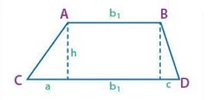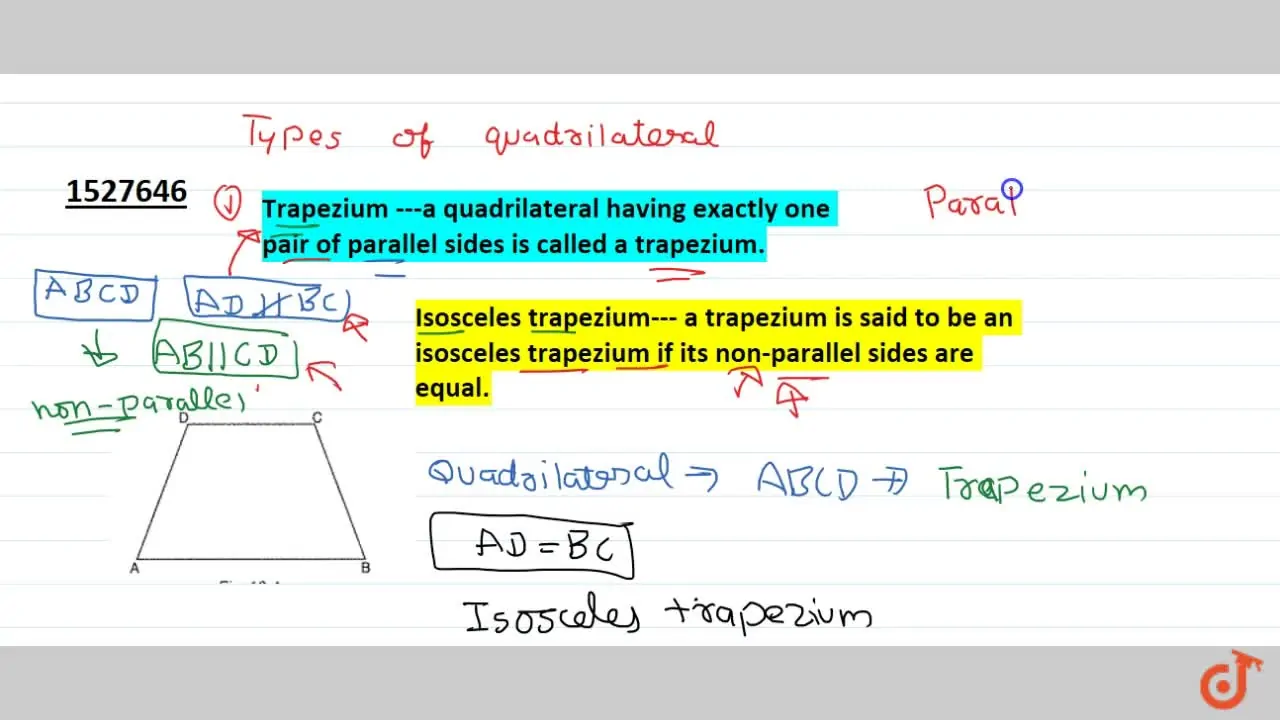Trapezium a quadrilateral having exactly one pair of parallel sides is called a trapezium.
Area of Trapezium
Understanding the different geometrical shapes is very important. In the previous chapter, we have learned a lot of shapes with examples as well. In this lesson, students will learn about trapezium. We will also discuss the area of a trapezium, including the area of trapezium formula, properties, and so on. Unless proper examples are seen, it becomes impossible to get the right solutions. So, for this, we will also solve some problems to get a better idea about it.
A trapezium is a type of quadrilateral that have two parallel sides. The other two sides are non-parallel. According to Euclidean Geometry, a polygon having four sides and four vertices is called a trapezium. The parallel and non-parallel sides of a trapezium are termed as bases and legs, respectively. It is also known by the term, ‘trapezoid’. In certain times, the parallelogram is also referred to as a trapezoid with two parallel sides.

Look at the above figure. We can find that it has got sides AB and CD which are parallel to each other. Note that there are non-parallel sides which are AC and BD. The ‘h’ represents the height of the trapezium, which is the distance between the two parallel sides.
What is the Shape of Trapezium?
When there is a question regarding the shape of a trapezium, different countries have defined it in different ways. Well, there are confusions when there is a distinction made between the terms, “trapezium” and “trapezoid.” In British, a trapezium is a quadrilateral that has got one pair of parallel sides. On the other hand, a quadrilateral with no parallel sides is termed as ‘trapezoids.’ In the U.S., a quadrilateral with no parallel sides is termed as a ‘trapezium’ while a quadrilateral having one pair of parallel sides is called ‘trapezoids.’
What are the types of trapezium?
Coming to the categorization of trapezium, it has got three different types:
- Scalene Trapezium – This is a type of trapezium that has the sides and angles of different measures
- Isosceles trapezium – This type of trapezium has the legs or the non-parallel sides of the trapezium of equal length
- Right Trapezium – This type of trapezium has at least two right angles.
What are the properties of a trapezium?
Understanding the properties of a trapezium is very important. Below are the important properties of trapezium:
- Exactly one pair of opposite sides are equal in a trapezium
- Except in isosceles trapezium, the non-parallel sides in a trapezium are unequal
- The diagonal intersect each other
- The midpoints of the line of the non-parallel sides are always found to be parallel to the bases.

Mid-segment = (AB + CD)/2
Area of a Trapezium
Calculating the area of a trapezium is possible when the two bases of a trapezium are taken and then multiplied by its altitude. Therefore, the area of a trapezium is as under:
Area of a Trapezium, = h(a+b)/2 square units.
Here, the bases are “a” and “b” and “h” is the height or the altitude. So, you have understood the area of a trapezium.
Perimeter of a Trapezium
Coming to the calculation of the area of a trapezium, it can be done by adding all the sides. So, the formula of area of a Trapezium is:
P = a + b + c + d units
Here, the sides of the trapezium are ‘a’, ‘b’, ‘c’ and ‘d.’

Related Videos:
Moving on, we will now have a look at some examples as this would be much easier to understand how to attempt the different questions of trapezium and others.
Q.1: The sum of the bases(parallel sides) is 40 cm, and its height is 20 cm. Can you find the area of the trapezium?
Solution: Here,
(a + b) = 40 cm
Given Height, h = 20 cm
Now applying the formula,
Area of a Trapezium, A = h(a+b)/2 square units.
Now substituting the given values,
A = (40/2)× 20
A = 20 × 20
A = 400 cm2.
So, the area of trapezium = 400 cm2.
Q.2: The sides of a trapezium is 4 cm, 5 cm, 6 cm and 7 cm. Find the perimeter of a trapezium
Solution: By applying the formula of the perimeter of trapezium, we know;
P = Sum of all the sides
P = 4+5+6+7
P = 22 cm
Hence, the perimeter is 22 cm.
Q.3: Can you calculate the area of the trapezium where the sum of the bases(parallel sides) is 70 cm and the height is 40 cm?
Solution: Here,
(a + b) = 70 cm
Height, h = 40 cm
We know that,
Area of a Trapezium, A = h(a+b)/2 square units.
Substitute the given values,
A = (70/2) × 40
A = 35 × 40
A = 1400 cm2.
So, the area of trapezium = 1400 cm2.
Q.4: The sides of a trapezium is 6 cm, 7 cm, 8 cm and 9 cm. Can you find its perimeter?
Solution: By applying the formula of the perimeter of trapezium, we know;
P = Sum of all the sides
P = 6 + 7 + 8 + 9
P = 30 cm
Hence, the perimeter is 30 cm.
Q.5: The length of the parallel sides of a trapezium are in the ratio 3 : 2 and the distance between them is 10 cm. If the area of trapezium is 325 cm², find the length of the parallel sides.
Solution:
Let the common ratio be x,
Then the two parallel sides are 3x, 2x
Distance between them = 10 cm
Area of trapezium = 325 cm²
Area of trapezium = 1/2 (p₁ + p₂) h
So, we have 325 = 1/2 (3x + 2x) 10
Now ⇒ 325 = 5x × 5
⇒ 325 = 25x
⇒ x = 325/25
Therefore, 3x = 3 × 13 = 39 and 2x = 2 × 13 = 26
Therefore, the length of the parallel sides area are 26 cm and 39 cm.
Important Chapters:



Solution:
Let the common ratio be x,
Therefore, the length of the parallel sides area are 26 cm and 39 cm.
Similar Questions
A quadrilateral having one and only one pair of parallel sides is called
View SolutionA quadrilateral having one and only one pair of parallelo sides is called a
View SolutionTrapezium as a quadrilateral having exactly one pair of parallel sides. Therefore if ABCD is a trapezium in which AB∣∣DC.Then (i)∠B+∠C=180∘(ii)∠A+∠D=180∘
View SolutionA quadrilateral having one and only pair of parallel sides is called: a parallelogram (b) a kite a rhombus (d) a trapezium
View SolutionDraw a trapezium and state the pair of parallel side
View SolutionThe quadrilateral in which only one pair of opposite sides are parallel is called a
View SolutionA quadrilateral whose only one pair of opposite sides are parallel, is called a
View SolutionComplete each of the following statements by means of one of those given in brackets again each: If one pair of opposite sides are equal and parallel, then the figure is ............... (parallelogram, rectangle, trapezium) If in a quadrilateral only one pair of opposite sides are parallel, the quadrilateral is .............. (square, rectangle, trapezium) A line drawn from the mid-point of one side of a triangle .................. another side intersects the third side at its mid-point. (perpendicular to, parallel to, to meet) If one angle of a parallelogram is a right angle, then it is necessarily a .................... (rectangle, square, rhombus) Consecutive angles of parallelogram are ...................... (supplementary, complementary) If both pairs of opposite sides of a quadrilateral are equal, then it is necessarily (rectangle, parallelogram, rhombus) if opposite angles of a quadrilateral are equal, then it is necessarily a ................... (parallelogram, rhombus, rectangle) If consecutive sides of a parallelogram are equal, then it is necessarily a ............. (kite, rhombus, square)
View SolutionA quadrilateral, in which both pairs of opposite sides are parallel and equal is called a
View SolutionBase each of the two parallel sides of a trapezium is called a base of the trapezium.
View Solution


